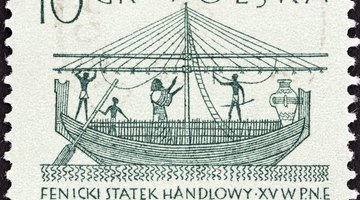"Phoenicians" was the name the ancient Greeks gave to a society of seafaring traders that emerged in the second millennium B.C. in present-day Lebanon and southwestern Syria. Acclaimed throughout the Mediterranean world for their luxury goods, the Phoenicians developed into an alliance of coastal cities around 1550 B.C. and established colonies as far as Iberia, but they never coalesced into a nation. Their trade as merchant sailors led the Phoenicians to develop various innovations, modern versions of which are still in use.
The First ABCs
The modern Western alphabet originated from a set of letters that the Phoenicians devised and the Greeks and Romans later adopted and modified. While older civilizations, like the Egyptians and the Sumerians, had developed pictorial writing with thousands of symbols, the Phoenicians sought a simpler system to record commercial transactions. The result was an phonetic alphabet in which characters represented the basic sounds from which all words are made. The original Phoenician alphabet contained only 22 consonants; the Greeks added symbols for vowel sounds in the eighth century B.C.
The Color of Kings
In Phoenician times, purple garments were markers of elite status. The Roman emperor Nero made the association official when he declared the color off-limits to anyone but himself, an edict that gave rise to the term "royal purple." The exclusive hue came from a dye the Phoenicians manufactured using the shells of mollusks known as murex. As many as 60,000 shells yielded a mere pound of dye, which made for a commodity that only the rich and powerful could afford. So closely was the society identified with its signature dye that the name "Phoenicians" is believed to come from the Greek word "phoinix," which translates to "purple-red."
Sailing with the Stars
The Greek historian Herodotus reported that around 600 B.C., the Phoenicians circumnavigated Africa. While that claim has yet to be substantiated, it speaks of the Phoenicians' reputation as master sailors that they acquired with the help of several innovations. Their navigational toolkit included an unprecedented understanding of the position of celestial bodies, in particular the North Star, or Polaris. The ancients called Polaris the "Phoenician Star" because the civilization's sailors had used it to determine their location and direction at night and in open waters, allowing for long-distance navigation. The Phoenicians are also given credit for pioneering significant upgrades to ships, including being the first to add a keel down the middle of the hull for improved balance.
Glass Half Full
Experts believe glass was discovered around 2,500 B.C. in Mesopotamia. Early historians like Pliny of classical Rome, however, were quick to attribute the invention of glass to the Phoenicians, who are considered the first to develop free-blowing as a method of crafting glass. This technique entails attaching a chunk of pliable, molten glass to a hollow tube and blowing through the opposite end to create a thin bubble that can be shaped into bottles, glasses and other vessels with the aid of tools.
Related Articles
References
- The Metropolitan Museum of Art: Heilbrunn Timeline of Art History - The Phoenicians
- U.S. History: Ancient Civilizations - Phoenicians
- University of Pennsylvania Museum of Archaeology and Anthropology: Patrick McGovern - Royal Purple
- Corning Museum of Glass: The Origin of Glassmaking
- Encyclopedia of the Peoples of Africa and the Middle East; Facts on File, Incorporated
Writer Bio
Since beginning her career as a professional journalist in 2007, Nathalie Alonso has covered a myriad of topics, including arts, culture and travel, for newspapers and magazines in New York City. She holds a B.A. in American Studies from Columbia University and lives in Queens with her two cats.











